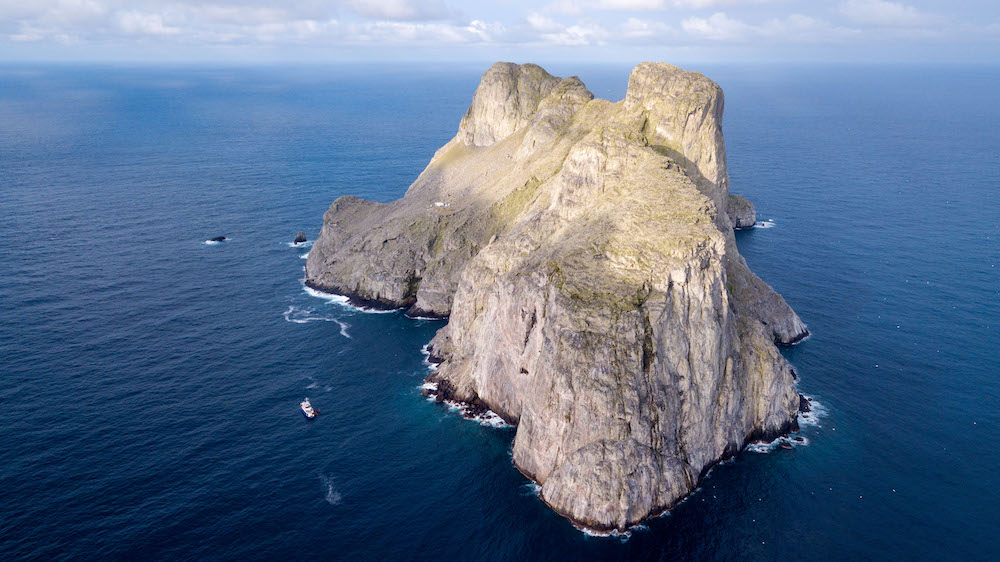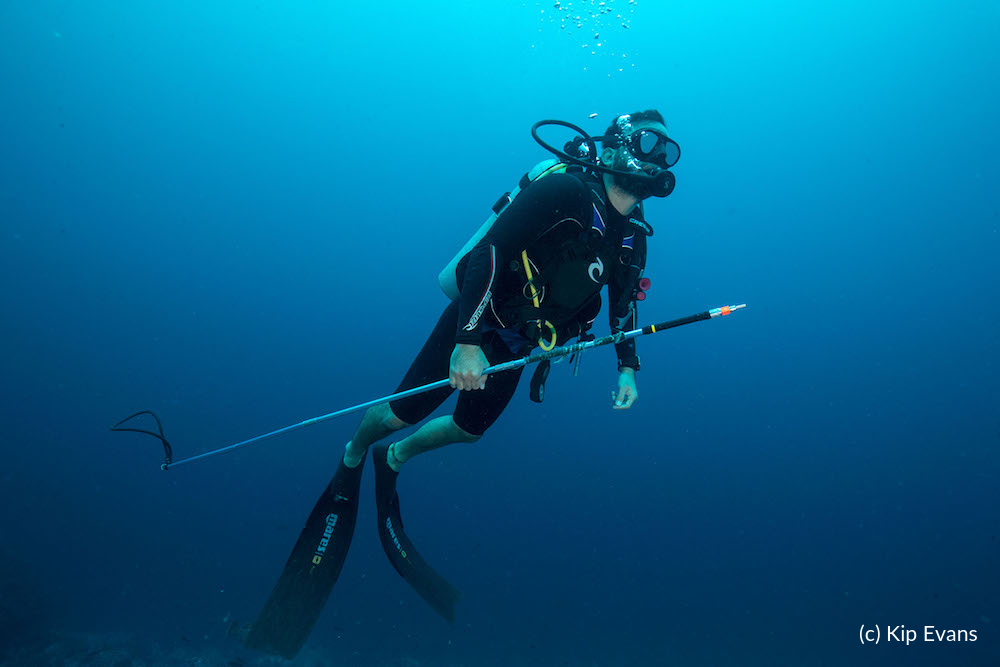
Date/Time
Date(s) - 08/08/2019 - 08/19/2019
12:00 am
Location
Malpelo Island
Categories
The Mission Blue Expedition Team traveled to Malpelo Island Hope Spot off the coast of Colombia in August 2019 to collect data on sharks’ migratory habits and document the unique triumphs and challenges involved in enforcing the local MPA and protecting the sensitive species that live there, including whale sharks, hammerhead sharks, and groupers. The trip offered opportunities to gain new insights about a place that has only been well explored for the past 30 years.

The expedition was organized with partners including the Malpelo Foundation, Conservation International Colombia, and Migramar. The delegation of scientists from Migramar on board included two stars: Dr. Mauricio Hoyos and Dr. Cesar Peñaherrera, both widely published in the scientific literature and two of the foremost experts on sharks in the Eastern Tropical Pacific.
Launching the Expedition

Malpelo Island, located in the Eastern Pacific, is rugged, remote and difficult to get to. We embarked on the expedition with Sandra Bessudo, marine conservationist and founder of Malpelo and Other Marine Ecosystems Foundation. Through her tireless work, Malpelo became a Mission Blue Hope Spot in 2016, which she champions. “It’s really a beautiful place,” her deep blue eyes light up as she prepares us for the expedition. It’s the place she’s worked her whole life to protect. Sandra was one of the first divers to explore the waters around Malpelo, in 1987. It was clear then that it was a treasure worth protecting.

“We are in the port of Buenaventura, on the Pacific Coast of Colombia, and we are ready to go to Malpelo,” Sandra Bessudo tells us, as the crew readies the ship to depart. “36 hours and we’ll be there.”

Challenges As a Marine Protected Area

Unfortunately, due to Malpelo’s remote location, difficult conditions and general lack of resources, enforcing the MPA can be challenging.
Colombia is an ocean country– its marine jurisdiction is 40% of its total surface extension. Its ocean area branches out from islands in its possession– Malpelo in the Pacific and San Andres and Providencia in the Caribbean carve out longer branches of marine jurisdiction than it would have without them. Like most countries though, Colombia isn’t doing so well by its ocean. Sustainable Development Goal 14 includes targets for 10% of marine areas protected by 2020 and sustainably managing and protecting marine areas by the same deadline.

Depending on what you measure, Colombia is close to those targets– or very far. Marine Conservation Institute’s MPAtlas shows that 12.93% of Colombia’s marine jurisdiction is designated to be protected, but only 4.10% is in highly protected marine protected areas, where fishing is highly restricted or forbidden.
With over half the surface of the ocean being fished, more refuges or marine protected areas (MPAs) where the fish are safe are needed.
Despite the protections granted by the Colombian government, not all marine life at Malpelo Island are safe. “The biggest threat to the protected area,” Sandra Bessudo shares, “is illegal fishing.” “It’s done mostly by vessels from neighboring countries… where they come in and enter the protected area [illegally], to capture snappers, groupers, sharks; all this biodiversity.”
It’s a difficult threat to counteract. Boats take 36 hours from mainland Colombia to Malpelo. Even with reports of illegal fishing, it’s hard to capture poachers.
The Colombian Navy patrols Malpelo Island for one-week tours each month. Monthly expeditions led by the Malpelo Foundation to serve a critical purpose– to study animal populations in Malpelo but also to keep a lookout for illegal fishing.

Diving operators visiting the island’s waters often catch poachers red-handed, and tourists and dive guides end up pulling lines out of the water to prevent them from harming Malpelo’s wildlife. On a recent trip, one dive guide, Erika Lopez, was moved to take action. She spotted fishing boats around the island, and took a few tourists over on a skiff to help pull out fishing gear in the water. Longlines set with buoys generally have to sit several hours before any fish bite, responding quickly to hooks in the water is critical.
Despite these challenges and poachers’ shady tactics, Malpelo’s MPA is still proving to be effective– studies show fish populations increasing. Driven leaders like Erika and Sandra match poachers’ greed with determination and zeal and give hope for the future of Mapelo’s wildlife.
A Cornucopia of Life

Malpelo might be inhospitable to humans, but it’s a haven for biodiversity– two endemic species of lizards and one species of crab are found nowhere else on the planet. Under the waves, at least 5 species of endemic fish call Malpelo’s waters home.
Unfriendly as it might be to humans, Malpelo is a haven for life. Seventeen species of marine mammals, endemic reptiles, 61 species of birds, 394 species of fish and 340 species of mollusks have been recorded on the island and surrounding marine protected area.
Due to Sandra’s efforts, their future looks brighter now than before. Malpelo’s newfound bounty shows that with dedicated conservation work we can restore places in the ocean to their thriving past.

Unique Needs for Protection

Scientific research conducted by the Malpelo Foundation showed that Malpelo’s wildlife ranged outside the previous boundaries of the protected area. Acting on this information, the Colombian government expanded it in 2017 to triple its previous size. Fishing is now forbidden in 27,096 square kilometers, extending far out from the island. It’s good news for fish and sharks!
But legal protections don’t always directly translate to real changes on the water. A larger protected area brings with it the enforcement challenges of patrolling vast areas at sea. Malpelo’s cast of partners work effectively to support enforcement, but more is needed.
“We really need a way to identify fishing vessels entering the protected area in real-time” Sandra tells me. “They turn off their location signaling a few miles outside the boundaries, which makes it very difficult to know they’re coming in.”

On deck, there was a frenzy of work. Pole spears, appendages for taking tissue samples, satellite tags and acoustic tags covered the tables where we had just eaten our breakfast. The scientists onboard the Ferox boat– named after one of the species of shark found in the area, the smalltooth sand tiger shark or Odontapsis Ferox– were getting ready to roll.
At the dining table, which doubled as an improvised lab desk, Mauricio, Cesar, and Sandra Bessudo, the founder of the Malpelo Foundation and Malpelo’s Mission Blue Hope Spot Champion, worked.
They connected acoustic and satellite tags to the metal wires that come with them and added the leader blade used to secure tags onto the sharks. Separately, they added blunt tips with a short (1-2 inch) hollow cylindrical end to some of the pole spears to take tissue samples.
“Besides tracking sharks through satellite tags, we want to understand if the populations are connected… DNA samples allow us to determine if the populations of sharks at Malpelo for example, share the same genetic pool as the sharks at Galapagos or Cocos.”
“It’s very important that there are protected areas.” Mauricio continues. “But, what happens when these [sharks] depart these islands?” Mauricio is referring to those other islands in the Eastern Tropical Pacific, where large observations of hammerheads and other shark species are often observed.

It’s a challenge for helping sharks recover, but Mauricio has a plan for that “we would like to protect them not just in isolated nations, but internationally.” The science work completed on Mission Blue’s expedition in Malpelo will help, in Mauricio’s words, “to find all these migratory routes in order to protect these places.”

Migramar, in Sandra Bessudo’s words, “is a network of scientists that shares information. This permits governments to take measures for conservation. This scientific information has helped us enlarge marine protected areas.”
Tagging and tracking sharks has already helped identify critical areas for conservation. “The Gulf of Tribugá in the north of the Colombian Pacific Coast is a nursery area for hammerhead sharks. So if we want to protect the adults that are here [in Malpelo], we also have to protect that place.” Sandra shares.
Despite the challenges, and poachers’ shady tactics, Malpelo’s MPA is still proving to be effective– studies show fish populations increasing. Driven leaders like Sandra match poachers’ greed with determination and zeal and give hope for a healthy future for Mapelo’s wildlife.
Read our new privacy policy here.